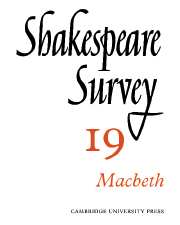Book contents
- Frontmatter
- ‘Macbeth’ in the Twentieth Century
- The Criminal as Tragic Hero: Dramatic Methods
- Antithesis in ‘Macbeth’
- Why was Duncan’s Blood Golden?
- Image and Symbol in ‘Macbeth’
- ‘Macbeth’ and The Furies
- Hell-Castle and its Door-Keeper
- ‘His Fiend-Like Queen’
- The Fiend-Like Queen: A Note on ‘Macbeth’ and Seneca’s ‘Medea
- Shakespeare at Street Level
- New Findings with Regard to the 1624 Protection List
- Shakespeare Productions in the United Kingdom: 1965
- The Royal Shakespeare Company 1965
- The Year's Contributions to Shakespearian Study: 1 Critical Studies
- 2 Shakespeare’s Life, Times and Stage
- 3 Textual Studies
- Index
- Plate Section
New Findings with Regard to the 1624 Protection List
Published online by Cambridge University Press: 28 March 2007
- Frontmatter
- ‘Macbeth’ in the Twentieth Century
- The Criminal as Tragic Hero: Dramatic Methods
- Antithesis in ‘Macbeth’
- Why was Duncan’s Blood Golden?
- Image and Symbol in ‘Macbeth’
- ‘Macbeth’ and The Furies
- Hell-Castle and its Door-Keeper
- ‘His Fiend-Like Queen’
- The Fiend-Like Queen: A Note on ‘Macbeth’ and Seneca’s ‘Medea
- Shakespeare at Street Level
- New Findings with Regard to the 1624 Protection List
- Shakespeare Productions in the United Kingdom: 1965
- The Royal Shakespeare Company 1965
- The Year's Contributions to Shakespearian Study: 1 Critical Studies
- 2 Shakespeare’s Life, Times and Stage
- 3 Textual Studies
- Index
- Plate Section
Summary
A considerable amount of recent research into early seventeenth-century music manuscripts has not only revealed who were the composers of the music for the King’s Men theatre but has also provided clues to the identity of some of the theatre musicians. So it has become necessary to examine much more carefully than has hitherto been possible Herbert’s 1624 Protection List (Plate V) for the names of those ‘imployed by the Kinge Ma:ties servante in theire quallity of Playinge as Musitions and other necessary attendante’. In particular it is necessary to combine the results of the above research with those of the research into the actors of the company, most exhaustively treated by Professor Baldwin in The Organization and Personnel of the Shakespearean Company and by Professor Bentley in volume II of his The Jacobean and Caroline Stage, and with the results of Professor Woodfill’s research into Musicians in English Society from Elizabeth to Charles I.
It is true that Professors Baldwin and Woodfill have each given some passing attention to the music in the theatre, relying heavily on Whitelocke’s observations in 1634 that ‘the Blackefryars Musicke . . . were then esteemed the best of common musitions in London’ and on Frederick Gerchow’s diary reference to the Blackfriars music? Professor Baldwin suggests musical functions for three names of the 1624 Protection List (Wilson, Toyer and Pallant) and remarks of the others that as far as he knows ‘there is no record as musicians’. Professor Bentley adds the identification of one more as a musician, Byland, and cautions about the distinction between a player and a musician not always being very definite. Obviously some theatre musicians would be expected to fill in as minor actors and attendants, especially in those plays which make little use of music.
- Type
- Chapter
- Information
- Shakespeare Survey , pp. 101 - 107Publisher: Cambridge University PressPrint publication year: 1967
- 2
- Cited by

